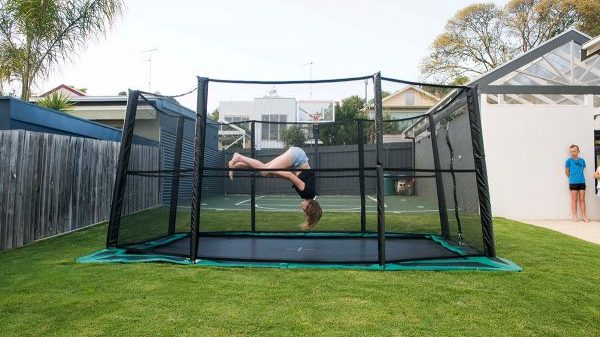Disclaimer & Safety Notes
Be aware that these tricks may be dangerous. If you have children that are trying new trampoline tricks, or any trampoline tricks, it may be useful to invest in a safety enclosure, which will help keep your child on the trampoline. Also note that the added pressure from the trampoline may affect their ankles and knees.
1. Basic Trampoline Tricks
Now that you’ve got a trampoline, you want to know what you can do with it, other than just jump of course.

Follow the tricks below and notice how they get more advanced as you master each one. The list starts with simple bounces and drops, explores basic jumps and tricks you can do while airborne, and ends with pullovers and handsprings.
#1 The Double Bounce
The double bounce is a classic on the trampoline and is often discovered by accident. Many jumpers already know and love the double bounce, with its extra height guarantee. Unlike other tricks on this list, you will need a friend to jump with. This trick is all about timing and takes some practice.
Start in the middle of the trampoline. Determine which of you will soar first (I suggest rock, paper, scissors). The idea is that one jumper will land first, pulling the jumping pad down for the second jumper.
When the second jumper lands, the jumping pad will zoom back up, giving the second jumper a height boost. Be careful, though. This trick can propel you so high into the air that you land on the ground instead of the trampoline. The pressure from the boost could buckle your knees, too.
#2 Twists
As far as beginning trampoline tricks though, twisting is among many jumpers’ favorites. Jump in the air and spin yourself to see how many times you can spin.
Consider starting slow, so you can get the sense of what twisting feels like. It sounds menial, but start with a quarter-twist, and try to nail the landing.
It’s not difficult to do a quarter twist, but the landing may prove to be a challenge. Once you know how to land a quarter, go for a half twist, or the 180 twists. Once you can land that, consider going for the full twist, or the 360 twists.
The full twist is landing where you lifted, facing the exact same direction. You could even take it a step farther than that and see if you can make it more than 360 degrees (bonus points if you nail the landing)!
#3 Seat Drop
Another simple trick, yet loved by many, is the seat drop. You could probably guess what this trick involves without much description, but it’s dropping to a seated position onto the trampoline mat and popping yourself back up to a standing one.
To start, jump in the air and straighten your legs in front of you. Allow yourself to land onto the trampoline pad in a seated position and bounce back up, pulling your legs back. There are various to this trick, as well. For example, instead of putting your legs straight ahead, you could cross them and try to uncross your legs as you bounce back up.
#4 Pike Jump
The pike jump requires some flexibility and patience to learn. First, you’re going to gain some height, so jump a few times to get yourself into the air. Then, you’re going to jut your legs out in front of you, like you’re going to go into a seat jump.
Instead, pull your arms forward and touch your toes. Lower your legs back down to meet the trampoline pad and repeat!
#5 Knee Drop
The knee drop closely resembles the seat drop, but instead of bouncing from a seated position, you’re bouncing on your knees. This is one of the easiest drops to learn, so it’s great if you’re not quite comfortable with the seat drop.
Keep your back straight and drop down to your knees, popping back up. There are ways to make this move more exciting. Once you have the basic movement down, you can add your arms to propel yourself a little higher.
Move your arms in a circular motion, as if you were trying to get up from a seated position without touching your hands to the ground, and pop yourself back up. Next, try jumping and then dropping. You’ll get much higher that way, but it will strain your knees a little.
#6 Front and Back Drop
The front drop is falling forward and bouncing back up. To start learning the front drop, start on your hands and knees.
Drop onto your stomach, crossing your arms underneath your chin (to prevent your face colliding with the trampoline pad), and pop back to your hands and knees. Once you’re comfortable with that movement, bend your knees and drop down, holding your hands under your chin.
After that becomes easy and you crave a more exciting experience, you can bounce and drop.
As you may have guessed, a backdrop is dropping on your back. This may scare a few jumpers because some people have a fear of falling. It’s very similar to a trust fall, only instead of a friend catching you, the trampoline will (which, is more reliable in some cases).
To get used to the feeling of falling backward, practice just falling first. Lift your toes off the pad and let yourself fall backward. After that, you could add a little bounce, or a big bounce if you’re comfortable and bounce back up.
Make sure that your neck is straight when you drop on your back to prevent whiplash or otherwise injuring yourself.
#7 Front and Back Pullover
A pullover is like the mid-point between a drop and a flip. Start by bouncing and gaining a little height, then do a front flip, but land on your back (similar to a mid-air somersault). From there, you can either stop, or do another one by bouncing and tucking your head under.
The back pullover is more difficult and a little more thrilling. The back pullover is essentially the same as a front pullover, only you’re landing bouncing on your back. Start by doing a backdrop.
When you bounce on your back, instead of popping back onto your feet, you’re going to throw your feet backward and land in a squat. Don’t be afraid to put your hands down when you’re pulling your legs behind you to keep your balance. Once you do this a few times, you can bounce higher and get more air.
#8 Front and Back Handspring
Handsprings are a combination of a flip and a handstand (hand-spring). For a front handspring, start at the edge of the trampoline, facing in, bounce, and throw yourself into a handstand. Once you have the handstand down, you’re going to pop your body into a forward flip.
A back handspring is the same thing, only going backward. Go to the edge of the trampoline, facing out, bounce, and flip backward, touching the trampoline mat with both hands and popping yourself to a standing position.
2. Advanced Tricks
As stated at the beginning of the article, these tricks can be dangerous.

Make sure you’re taking safety precautions, such as acquiring a safety enclosure, before attempting these tricks. So, you’ve learned how to do handsprings, pullovers, and other basic bounces.
You want something more exciting and thrilling to try. These advanced tricks include different kinds of gravity-defying flips to attempt.
#1 Front and Back Flip
Flips are a staple to trampoline jumping, yet many find them gut-wrenching to accomplish. Front flips are a little easier, so start by jumping a few times to gain enough air. On that jump where you want to flip, jump in the same spot as your other jumps.
Don’t jump forward because you won’t have enough time in the air to complete the flip. Once you’re ready to perform the flip, bring your arms over your head and sweep downward ferociously, grab your knees and flip. Don’t get discouraged if you don’t land on your feet the first time. Practice the timing and you’ll get it.
Backflips are known to be a little more challenging than their front counterparts, however, it works in the same way as a front flip does. So, if you master the front flip, the backflip will be easier to learn. To begin, jump a few times to gain height.
Bring your legs into your chest and bring your arms to your knees. Make sure you have enough height, or you’ll land on your knees. There are many methods of mastering the fear of doing backflips.
For example, some people use pillows and gradually take away pillows as they gain more height and notice what it feels like to have their back in the right position to properly flip. Research some methods for mastering that fear to find the right one for you.
#2 Side Flip
Now that you’ve mastered front and backflips, it’s time for a change. Instead of flipping back and forth, you’ll flip to the side with this trick. I recommend having a safety enclosure while learning this trick, as you could propel yourself off the side of the trampoline.
Jump a few times to get enough height and lower your shoulder and bend your elbow to prepare for the flip. Jump off the leg that’s under your bent arm, bringing your other leg into a tuck and roll position as you spin.
#3 The Cody
The Cody is a complicated backflip, in which you bounce off your stomach and go into a backflip using that momentum. There are two ways to start The Cody: either with a backflip flip landing on your stomach, or a direct front drop.
If you decide to front drop-in, you’ll need more height than if you did a backflip because you won’t get as much momentum. Then, you’ll pop off the trampoline pad from the front drop and use that momentum to propel yourself into a backflip, landing on your feet.
From drops and handsprings to backflips and the Cody, you’ve learned enough trampoline tricks to impress your friends and family members. Maybe it’s time they start learning some, too.